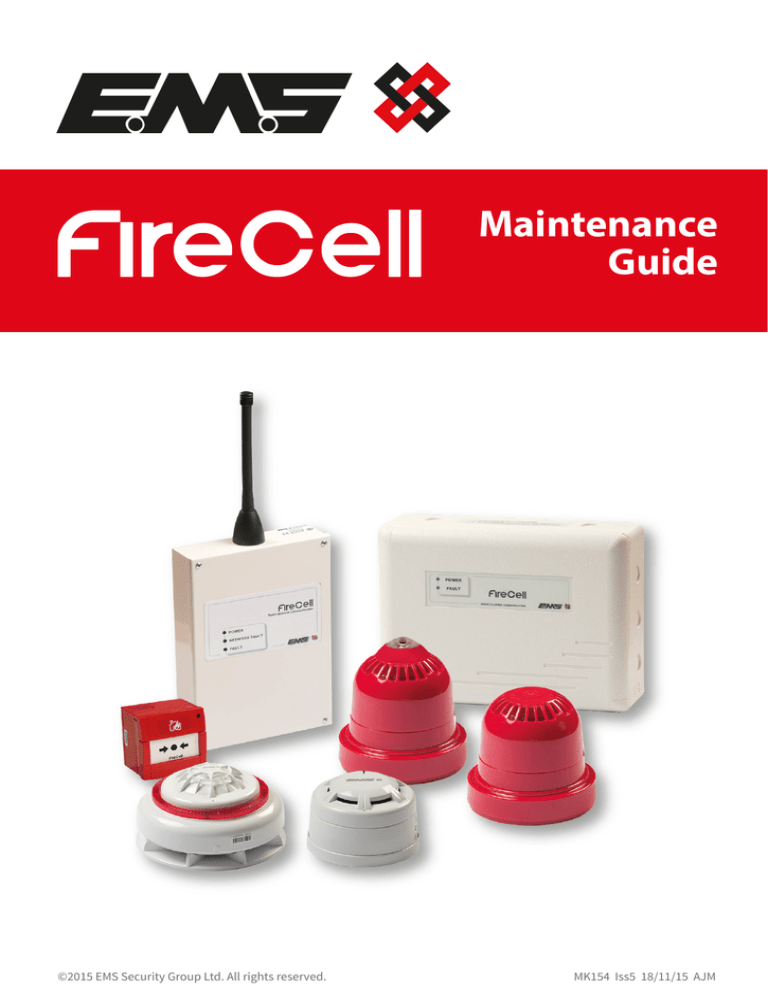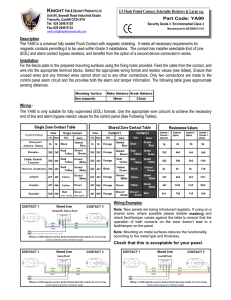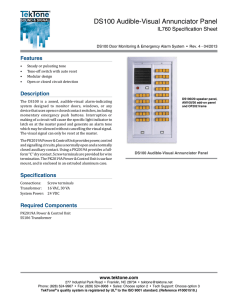
Maintenance
Guide
©2015 EMS Security Group Ltd. All rights reserved.
MK154 Iss5 18/11/15 AJM
Contents
Overview
3
Pre-testing Guidelines
4
Daily Maintenance
4
Weekly Maintenance
5
Six Monthly Maintenance
6
Annually Maintenance
7
Four-Five Yearly Maintenance
8
Battery Information
9
Fire Control Panel / PSU Batteries
9
Page 2 of 10
Overview
It is important that fire alarm systems are regularly checked to ensure their continued correct
operation. The maintenance of fire alarm systems should be in accordance with applicable local
installation codes. This maintenance guide has been written in conjunction with British Standard
BS5839: Part 1.
!
Important Note: other local installation codes may vary.
The owner or other person having control of the premises should appoint a responsible person to
supervise the system. The person should be given sufficient authority to ensure the carrying out of
any necessary work to maintain the system in correct operation, the maintenance of the log book,
and the servicing recommended.
Procedures should be laid down for dealing with alarm of fire, fault warning or taking part or all of
the system out of service. These procedures should be approved by the appropriate fire authority
before implementation.
The responsible person should ensure that users of the system are instructed in its proper use. Any
members of staff who will be concerned with first aid fire-fighting should be instructed in the
correct interpretation of the indications given, and their relationship with the building layout. All
management, staff and, in most cases, long term occupants, should be instructed and practised in
the proper actions to be taken in the event of a fire.
The responsible person should establish a liaison with those responsible for changes in or
maintenance of the building fabric (including redecoration, etc.) to ensure that their work does not
cause faults on, or otherwise interfere with the operation of, the fire alarm system. If structural or
occupancy changes occur or are planned, then the responsible person should ensure that any
necessary changes to the fire alarm system are considered at an early stage.
The responsible person should ensure that a clear space is presented in all directions below every
detector, and that all manual call points remain unobstructed and conspicuous.
Page 3 of 10
Pre-testing Guidelines
It is important to ensure that operation during testing does not result in a false fire alarm. If the fire
alarm system is connected to an automatic dialling unit, then transmission should be prevented
(for instance by disconnection) before the routine test is carried out, since under normal conditions
test calls are not permitted. In certain equipment using automatic dialling, it is possible to prevent
transmission of signals by lifting a telephone receiver. Use of this function to inhibit transmission is
deprecated, but where used the inhibited state should be indicated by the use of a notice on the
control equipment.
If transmission of signals to a remote manned central station is prevented during test, a visual
indication of this state should be given at the control equipment. If a link to a remote manned
central station is to be used during the test, then it is essential to notify the centre before
undertaking the test, unless a recognised test procedure is regularly carried out at an agreed time.
The occupants of the premises should be notified of any test of the system that may result in the
sounders being operated.
Daily Maintenance
A check should be made every day to ascertain the following:a)
Ensure that the front panel of the Master controller is indicating a normal condition (i.e. no
alarm or faults LED’s are lit and the LCD is displaying the correct date and time.
Note: If the panel is not indicating a normal condition, record the condition in the log book and take
any necessary action. Refer section 1.1.
b)
Check that any fault recorded on the previous day has received attention.
If any connection to the public fire brigade or other remote manned central station is not
continuously monitored then it should be tested daily in accordance with the suppliers
instructions.
Note: On 1 day each week the daily test will be incorporated in the weekly test.
Page 4 of 10
Weekly Maintenance
These checks would normally be carried out by a responsible member of the building staff. They
should also be carried out by the service engineer after all routine maintenance checks.
WARN ALL PERSONNEL THAT THE SOUNDERS ARE ABOUT TO BE TESTED.
TELEPHONE CENTRAL STATION AND INFORM THEM THAT A TEST IS ABOUT
TO TAKE PLACE
!
Note: When reference is made to the controller, the actions should be carried out / checked on all
repeater units fitted on the system.
The fire alarm system testing should be in accordance with applicable local installation codes.
The following checks should be made:a)
If necessary, clean the front panel of the controller with a suitable cleansing agent. i.e. anti
static cleansing wipes.
b)
Set one device (a call point ) from one zone into alarm, at the call point insert the test key
provided into slot in bottom of call point, check that the system responds as follows:i)
ii)
iii)
iv)
v)
vi)
vii)
viii)
The controller’s internal buzzer sounds in a continuous tone.
The common red “FIRE” symbol on the controller front panel illuminates.
The appropriate red “FIRE ZONE” LED on the controller front panel flashes.
The general and zonal sounders operate.
The xenon beacons operate.
The alphanumeric display gives the location of the alarm.
The repeater panel indicates the same information as the main control panel.
The appropriate plant shutdown operates.
c)
Record the device used to initiate the test in the site log book. Accept the alarm on the main
fire alarm control panel and reset system via appropriate function pushes on control panel.
d)
Check the condition of the printout on the printer attached to the system and replace the
thermal paper if it is becoming faint.
e)
Ensure that the printer has an adequate supply of paper.
f)
Contact monitoring control room to confirm test signal was received and signal is now in
normal status. Confirm tests are now completed.
Any defect should be recorded in the Fire Alarm System log book and appropriate action taken.
Six monthly maintenance should be based on a risk assessment, taking into account the type of
system installed, the environment in which it operates in and other factors that may affect the
long term operation of the system as per applicable local installation codes.
Page 5 of 10
Six Monthly Maintenance
Note: When reference is made to ancillary equipment, the actions should be carried out / checked
on all Radio Cluster Communicator units fitted on the system and also the Radio Hub were
applicable.
The following checks should be made:a)
Perform the weekly checks.
b)
Check the entries in the log book and carry out any necessary action.
c)
Test all call points and 50% of automatic devices and confirm correct operation as detailed in
weekly tests point
d)
Check device signal strength readings against the recorded commissioning levels as per
FireCell minimum requirements.
e)
Check all fault indicators by simulating a FAULT condition in each zone either:
i)
ii)
Removing a detector from its base.
Disconnecting the local circuit from an ancillary unit’s circuit.
f)
Visually check the condition of the controller and other ancillary equipment for signs of
moisture ingress and other deterioration.
g)
Make overall visual examination, test fixings and adjust if necessary.
Check voltage (24V, 12V, 6V), test current draw (mA), test stand-by batteries on load. Check all
battery connections. Check all batteries in control panels and ancillary control equipment. The use
of an ACT meter is recommended.
h)
The alarm functions of the control and indicating equipment should be checked by the
operation of a detector or call point in each zone. The operation of the alarm sounders and any link
to a remote manned centre should be tested.
i)
Ensure that a clear space of at least 750 mm is preserved in all directions below heat and
smoke detectors, and that all manual call points remain unobstructed and conspicuous.
j)
Check any remote aerial connections for damage. A resistance of 47K should be seen
between the centre and outer cores of the coax connector located at Radio Hub or Radio Cluster
Communicator end of the aerial cable.
Any defect should be recorded in the Fire Alarm System log book and appropriate action taken.
Page 6 of 10
Yearly Maintenance
Note: When reference is made to ancillary equipment, the actions should be carried out / checked
on all Radio Cluster Communicator units fitted on the system and also the Radio Hub were
applicable.
The following checks should be made:a) Carry out all six monthly checks.
b) Visually check the inside and outside of the controller / repeater panel for damage.
c) Check for damage to, and paint on, all detection devices.
d) Check for damage and accumulations of dirt on smoke detectors.
DO NOT CLEAN; these units MUST be exchanged and returned to the factory for service. An
analogue value of 35 for smoke detectors indicates service required.
e) Check the fixings for the controller and all detectors, sounders and ancillary equipment which
forms part of the fire detection system.
f)
Check the cable fixings at the controller and each ancillary device for correct connection.
g) All remaining detectors and call points not tested in six monthly checks should be tested for
correct operation.
Any defect should be recorded in the Fire Alarm System log book and appropriate action taken.
Page 7 of 10
Four-Five Yearly Maintenance
The following checks should be made:a)
Carry out all annual checks.
b)
Inform the responsible person that “x” number of batteries require to be replaced.
c)
Replacement batteries are required in the following equipment;
i)
ii)
d)
All Radio Type Device Variants
Radio Cluster Communicators
The Battery Information section refers to recommended replacement battery requirements.
e)
The responsible person should ensure that every five years (or more frequently if the
building electrical system is tested at shorter intervals) the installation should be tested in
accordance with the testing and inspection requirements of current IEE wiring regulations. Any
defect should be recorded in the log book and reported to the responsible person, and action
should be taken to correct it.
f)
On completion of the work, a certificate of testing should be given to the responsible person.
Page 8 of 10
Battery Information
FireCell Equipment Type Typical Battery Life Batteries Required
FireCell Control Panel/PSU Up to 5 years*
Part Number(s)
As per system design† -
RCC
Up to 5 years*
1x 6V 4Ah
FC-006-004
Callpoint
Up to 5 years*
6 x AA Alkaline cells
FC-809-000
Detector
Up to 5 years*
6 x AA Alkaline cells
FC-809-000
Combined Sounder &
Detector
Up to 5 years*
3 x AA Alkaline cells
3 x C Alkaline cells
FC-809-000
FC-810-000
Sounder / Sounder-Strobe Up to 5 years*
or Visual Indicator
3 x AA Alkaline cells
3 x C Alkaline cells
FC-809-000
FC-810-000
Up to 5 years*
6 x AA Alkaline cells
FC-809-000
Input/Output Unit
* Typical 5 year battery life, based on normal usage
† See the Fire Control Panel / PSU Batteries section below for available batteries.
Fire Control Panel / PSU Batteries
Note: Fire Panel and associated PSU batteries used will vary according to system design.
Battery Type / Quantity
Part Number
12V 9Ah / 2 required
FC-012-009
12V 12Ah / 2 required
FC-012-012
12V 15Ah / 2 required
FC-012-015
12V 17Ah / 2 required
FC-012-017
12V 26Ah / 2 required
FC-012-026
Page 9 of 10
Third Party Accredited
ISO 9001 ISO 13485 ISO 14001
www.emsgroup.co.uk
The information contained within this literature is correct at time of publishing. The EMS Security Group Ltd reserves the right to change any information regarding products as
part of its continual development enhancing new technology and reliability. The EMS Group advises that any product literature issue numbers are checked with its head office
prior to any formal specification being written.
Page 10 of 10




